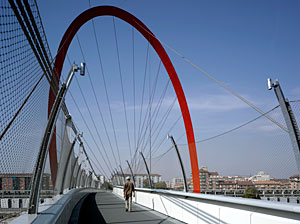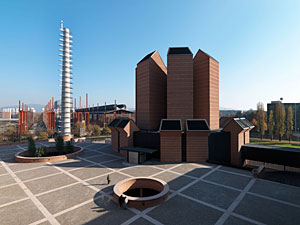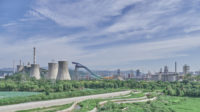In 1999, when Turin, Italy, was chosen to host the 2006 Olympic Winter Games, observers attributed the International Olympic Committee’s selection over favored Sion, Switzerland, to Turin’s million-person population and its close proximity to the Western Alps.


Then there was the city’s promise of manmade wonders: 2.6 billion euros in government investment that included the construction of new sporting venues and hotels in and around the Piemonte city. In the urban core, those projects included a 2,500-bed Olympic Village designed by a variety of European architects; the Palasport Olimpico, a stadium designed by Arata Isozaki with Pier Paolo Maggiora; and Lingotto Oval, a speed skating arena designed by HOKSVE, Studio Zoppini Associati, and Buro Happold. The city’s grand plan also called for renovating two existing sporting venues: the mid-century Palavela and the Deco-era Stadio Comunale, which had closed in 1990.
Olympic venues don’t always prove useful for host cities once the Games end, but Turin so far has managed to successfully repurpose the dozen major facilities it constructed for the two-week-long sporting event. Moreover, the buildings have contributed to the northern Italian city’s long-time effort to redevelop itself into a vibrant, post-industrial metropolis. With all eyes turned toward the upcoming summer contests in China, Turin’s conversion of Olympic facilities to everyday use offers a view to the tasks that Beijing officials will soon have to undertake.
According to Carlo Spinelli of the Turin-based Metropolitan Urban Center, preserving Olympic venues helps “sustain Torino’s Olympic legacy.” But it’s more than that. These facilities have reinvigorated neighborhoods, says Benedetto Camerana, principal of Camerana & Partners, the firm that oversaw the design of the Olympic Village. The million-square-foot complex—which wraps around a Modernist fruit-and-vegetable arcade constructed in 1934—is now a thriving multi-use area featuring offices and social housing. It should become even livelier in the next several months as Pirelli Real Estate, a private company, takes over common-area maintenance and rents out the remaining residential units.
Moreover, the Olympic Pedestrian Bridge continues to be heavily trafficked. It connects the Olympic Village to Lingotto, the Fiat factory converted by Renzo Piano into an entertainment and retail center in 1994. Designed by Camerana with the French architect Hugh Dutton, the footbridge is characterized by a 230-foot tall red arch. “It is a symbol of lightness that contrasts the heavy industry of the city’s past,” Camerana explains.
Responsibility for operating former Olympics destinations belongs to Torino Olympic Park, a 50-person foundation with offices in the former Olympic Village. The city created the foundation in September 2006 to manage and develop the Winter Games venues so they continue to draw tourists. So far, the foundation is meeting its goal, says spokeswoman Linda Brizzolara, noting that the recent quarterfinals of the Union of European Basketball Leagues, held within the Palasport Olimpico, attacted 2,000 foreign visitors.
And tourism is vital to the foundation itself: The Italian government initially funded Torino Olympic Park with a 20-million-euro grant, but expects the organization to start paying for itself through facility rentals by 2011. Downtown buildings should produce most of that revenue, Brizzolara says, thanks to their convenient location and original designs that are more flexible than farther-flung sporting venues.
Indeed, the centrally located, 13,000-seat Palasport Olimpico has been a hot venue. In 2007, it was booked 200-plus days for corporate functions, concerts, sporting games, and other events; the foundation hopes to boost that activity by 50 percent this year. Moreover, the city is building on that momentum by constructing a swimming pavilion on an adjacent site. Also designed by Isozaki and Maggiora, the new pavilion will serve as a visual counterpoint to the Palasport Olimpico, taking its straightforward rectilinear volume, tilting it upward on one side, and topping the structure with a folded roof. The 20-million-euro project should be finished by 2009.
Overall, former Olympic facilities hosted events totaling 938 days and drawing 860,000 spectators in 2007, and those numbers are expected to nearly double this year, says Brizzolara. It’s a potent shot in the arm for Turin, which launched its revitalization effort in the 1980s with the Lingotto factory conversion. More recently, the city redeveloped three factory zones into neighborhoods known as “spines”—an undertaking that gave rise to the modern Santo Volto church, designed by the Swiss architect Mario Botta, on the site of a former steel mill. Nontraditional in its design, the church embodies Turin’s eagerness to embrace the 21st century.
Even without a decades-old master plan to guide it, Beijing can look to Turin for guidance. In the long-term, Olympics venues can be a great asset to a city, Brizzolara says, but reuse strategies must be considered early on and implemented soon after the Olympic torch leaves town.




Post a comment to this article
Report Abusive Comment